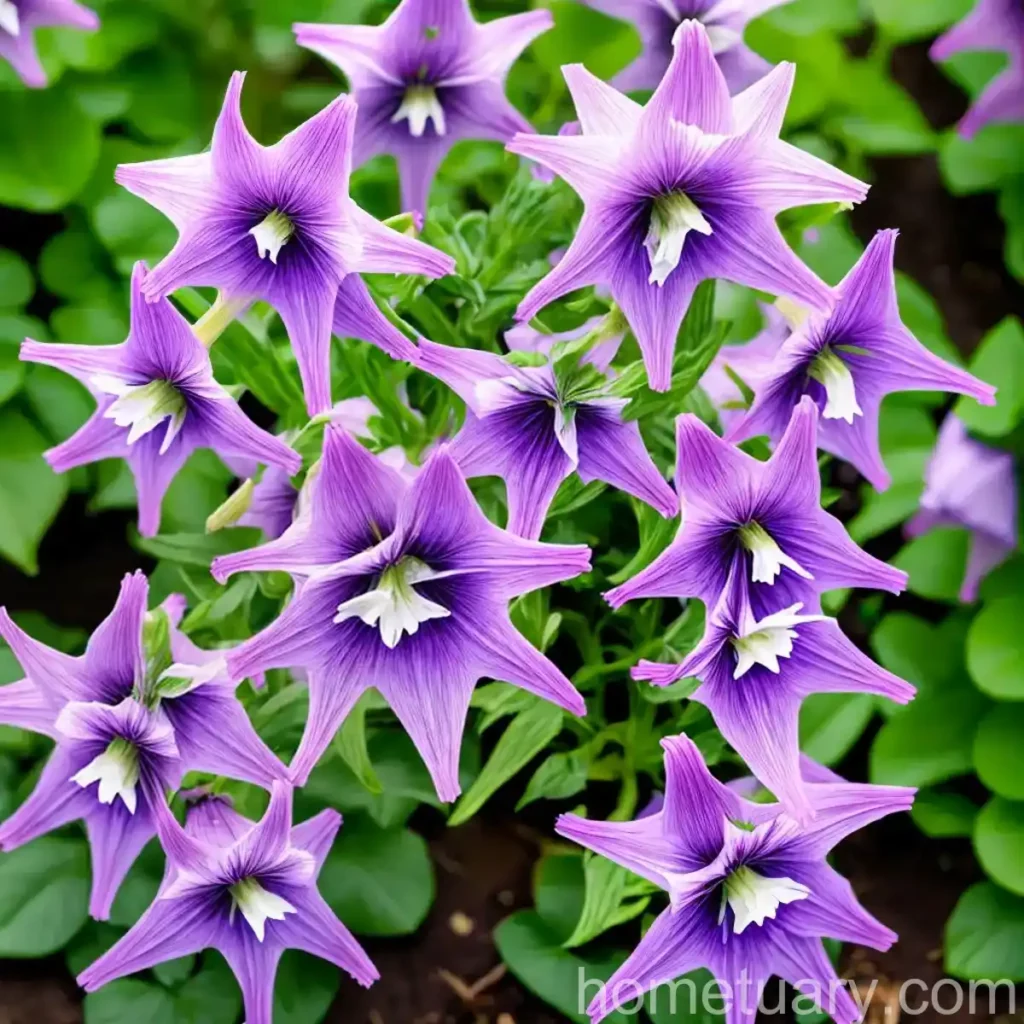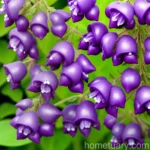Odessa Bellflower (Campanula glomerata var. dahurica ‘Odessa’) Care Guide
Campanula glomerate var. dahurica ‘Odessa’, commonly known as Odessa bellflower, is a stunning perennial plant that belongs to the Campanulaceae family. This elegant plant is valued for its attractive blooms and its ability to thrive in a variety of growing conditions. In this comprehensive care guide, we will delve into the various aspects of cultivating and caring for the Odessa bellflower, ensuring that you can enjoy its beauty in your garden for years to come.
What is Odessa Bellflower (Campanula glomerata var. dahurica ‘Odessa’)?
Odessa bellflower, scientifically known as Campanula glomerata var. dahurica ‘Odessa’, is a herbaceous perennial plant that originates from the Campanula genus. This delightful plant is characterized by its clustered, bell-shaped blooms that form dense globes atop sturdy stems. The flowers are an enchanting shade of deep violet-blue, creating a captivating display in any garden setting.
The plant’s foliage is equally appealing, with lush, lance-shaped, dark green leaves that provide an attractive backdrop to the vibrant blossoms. Odessa bellflower typically reaches a height of around 3 feet and spreads to about 18 inches, making it an excellent choice for borders, cottage gardens, and mixed perennial beds.
Key Takeaways – Odessa Bellflower (Campanula glomerata var. dahurica ‘Odessa’)
Culture
- Common Name: Odessa bellflower
- Scientific Name: Campanula glomerata var. dahurica ‘Odessa’
- Plant Type: Herbaceous perennial
- Family: Campanulaceae
- Native Range: Eastern Europe, Western Siberia, Caucasus
Uses
- Landscape: Borders, cottage gardens, mixed perennial beds
- Containers: Suitable for container gardening
- Cut Flowers: Ideal for floral arrangements
Water
- Watering Needs: Moderate
- Soil Moisture: Well-draining soil
- Drought Tolerance: Moderate
Sunlight
- Light Requirements: Full sun to partial shade
- Optimal Sun Exposure: 6-8 hours of direct sunlight
Fertilizer
- Feeding: Fertilize in spring with a balanced, all-purpose fertilizer
- Frequency: Once per month during the growing season
Soil
- Soil Type: Rich, fertile soil
- pH Level: Slightly acidic to neutral (pH 6.0-7.0)
- Soil Texture: Well-draining
Pruning
- Deadheading: Regular deadheading to prolong blooming
- Cut Back: Trim back after flowering to encourage reblooming
Propagation
- Propagation Methods: Division, seeds, basal cuttings
- Best Time for Division: Spring or fall
Container Popularity
- Suitable for Containers: Yes
- Container Size: At least 12 inches in diameter
- Soil Requirements: Well-draining potting mix
Common Diseases
- Disease: Downy mildew
- Preventive Measures: Proper air circulation, well-draining soil
Disease Diagnosis
- Signs: Yellowing or browning of leaves, white mildew on foliage
- Treatment: Fungicidal treatments, improved air circulation
Common Pests
- Pests: Aphids, slugs, snails
- Control Methods: Insecticidal soap, beer traps for slugs and snails
Botanist’s Tips
- Companion Plants: Coreopsis, Salvia, Rudbeckia
- Pollinator-Friendly: Attracts bees and butterflies
- Deer Resistance: Deer tolerant
Fun Facts
- Symbolism: Represents gratitude and faith
- Medicinal Uses: Historically used in herbal medicine
Links to External Resources
- Royal Horticultural Society – Campanula glomerata var. dahurica ‘Odessa’
- Missouri Botanical Garden – Campanula glomerata var. ‘Odessa’
Odessa Bellflower (Campanula glomerata var. dahurica ‘Odessa’) Care Guide
Are you ready to bring the beauty of Odessa bellflower into your garden? Let’s explore the essential care requirements for this captivating perennial.
Odessa Bellflower Culture
Scientific Name and Taxonomy
- Common Name: Odessa bellflower
- Scientific Name: Campanula glomerata var. dahurica ‘Odessa’
Plant Type and Family
- Odessa bellflower is a herbaceous perennial that belongs to the Campanulaceae family. It is a member of the Campanula genus, which comprises over 500 species renowned for their bell-shaped flowers.
Native Range
- The plant is native to Eastern Europe, Western Siberia, and the Caucasus region. It thrives in temperate climates and has adapted to various growing conditions.
Uses of Odessa Bellflower
Odessa bellflower offers numerous landscaping opportunities and is esteemed for its ornamental and practical uses.
Landscape Uses
- Borders: Create captivating borders by planting Odessa bellflower alongside other perennials.
- Cottage Gardens: Its charming appearance makes Odessa bellflower an excellent addition to traditional cottage garden settings.
- Mixed Perennial Beds: Blend this plant with other perennials to create visually appealing and diverse garden beds.
Containers
- Odessa bellflower is well-suited for container gardening, allowing its beauty to thrive on patios, decks, and balconies.
- Container Requirements: Choose a container with adequate drainage and space for the plant to spread its roots.
Cut Flowers
- The attractive blooms of Odessa bellflower make it an ideal choice for cut flower arrangements, adding a touch of elegance to indoor spaces.
Watering Needs
Proper watering is essential for the health and vitality of Odessa bellflower.
Water Requirements
- Odessa bellflower thrives in moderate moisture levels, requiring regular watering to maintain soil moisture.
- Common Issues: Overwatering can lead to root rot, while underwatering may cause stunted growth and reduced flowering.
Soil Moisture
- Well-draining soil is crucial for preventing waterlogging, allowing excess moisture to drain efficiently.
Drought Tolerance
- While Odessa bellflower can withstand short periods of dryness, consistent drought conditions can stress the plant.
Sunlight Preferences
Understanding the sunlight needs of Odessa bellflower is key to fostering its flourishing growth.
Light Requirements
- Odessa bellflower thrives in full sun to partial shade, performing best with 6-8 hours of direct sunlight daily.
- Partial Shade: It can tolerate partial shade, particularly in regions with intense afternoon sun.
Optimal Sun Exposure
- Plant Odessa bellflower in locations where it can receive ample sunlight, promoting strong, healthy growth and prolific blooms.
Fertilizer Application
Proper fertilization supports the development of vibrant foliage and abundant blooms in Odessa bellflower.
Feeding Schedule
- Apply a balanced, all-purpose fertilizer in spring to provide essential nutrients for the growing season.
- Frequency: Fertilize once per month during the active growing period to maintain plant vigor.
Soil Requirements
Understanding the soil preferences of Odessa bellflower is crucial for creating an optimal growing environment.
Soil Type
- Odessa bellflower thrives in rich, fertile soil with good nutrient retention capacity.
- Soil Texture: Well-draining soil is essential to prevent waterlogged conditions that can compromise root health.
pH Level
- Maintain slightly acidic to neutral soil conditions with a pH range of 6.0-7.0 to support nutrient uptake and overall plant health.
Pruning Practices
Implementing appropriate pruning techniques ensures the continued beauty and vitality of Odessa bellflower.
Deadheading
- Regularly remove spent blooms to promote continuous flowering and prevent the development of seed pods.
- Benefits: Deadheading redirects the plant’s energy towards producing new flowers, extending the blooming period.
Cut Back After Flowering
- Trim back the faded flower stalks in late summer or early fall to encourage the growth of fresh blooms, prolonging the plant’s flowering season.
Propagation Methods
Explore the various propagation techniques to expand your Odessa bellflower collection and share its beauty with others.
Division
- Propagate Odessa bellflower through division, splitting the plant into smaller sections in spring or fall for new plantings.
- Best Time for Division: Early spring or after the blooming period in fall.
Seeds
- Collect seeds from mature blossoms and sow them in well-prepared, moist soil for germination and the cultivation of new plants.
Basal Cuttings
- Take basal cuttings from healthy shoots and root them in a suitable growing medium to establish independent plants.
Odessa Bellflower in Containers
Cultivating Odessa bellflower in containers presents unique opportunities and considerations.
Container Suitability
- Odessa bellflower adapts well to container gardening, allowing you to showcase its beauty on patios, balconies, and decks.
- Container Size: Select containers with a diameter of at least 12 inches to accommodate the plant’s root system adequately.
Soil Requirements
- Use well-draining potting mix to ensure proper moisture management and root health in container-grown Odessa bellflower.
Common Diseases and Remedies
Prevent and address potential diseases to safeguard the health and vitality of Odessa bellflower.
Common Disease
- Downy Mildew: A fungal disease that causes yellowing of leaves and the development of a white, powdery mildew on the foliage.
- Preventive Measures: Ensure proper air circulation and maintain well-draining soil to minimize the risk of downy mildew.
Disease Diagnosis
- Signs: Look for signs of yellowing or browning of leaves and the presence of white mildew on the foliage, indicating potential downy mildew infection.
- Treatment: Implement fungicidal treatments as needed and focus on improving air circulation around the plant.
Common Pests and Control Measures
Keep an eye out for common pests that may affect Odessa bellflower and address infestations promptly.
Pests
- Aphids: Small, sap-sucking insects that can cause damage to the foliage.
- Slugs and Snails: These pests can feed on the tender leaves and flowers of Odessa bellflower.
- Control Methods: Use insecticidal soap for aphid control and employ beer traps to capture slugs and snails.
Botanist’s Tips for Odessa Bellflower
Leverage the expertise of botanists and horticulturalists for valuable insights into cultivating and enjoying Odessa bellflower.
Companion Plants
- Coreopsis: Pair Odessa bellflower with coreopsis for a vibrant color contrast and a diverse mix of flower shapes in the garden.
- Salvia: The tall, spiky blooms of salvia complement the rounded clusters of Odessa bellflower, creating a visually striking combination.
- Rudbeckia: The cheerful blooms of rudbeckia harmonize with the violet-blue flowers of Odessa bellflower, enhancing the garden’s visual appeal.
Pollinator-Friendly
- Odessa bellflower’s attractive blooms attract bees and butterflies, contributing to the garden’s ecosystem and supporting pollinator populations.
Deer Resistance
- A key advantage of Odessa bellflower is its resistance to deer browsing, making it a reliable choice for deer-prone areas.
Fun Facts about Odessa Bellflower
Discover intriguing and captivating facts about Odessa bellflower that enrich its cultural and horticultural significance.
Symbolism
- Odessa bellflower symbolizes gratitude and faith, making it an ideal gift or addition to gardens with symbolic meanings.
Medicinal Uses
- Historically, the plant was used in herbal medicine for various remedies and health benefits, demonstrating its cultural and practical significance.
Explore Further: Learn more about the cultural and natural significance of Odessa bellflower in folklore and traditional practices.
Links to External Resources
For additional information and detailed insights into Odessa bellflower, explore reliable external resources provided by renowned horticultural organizations.
- Royal Horticultural Society – Campanula glomerata var. dahurica ‘Odessa’
- Missouri Botanical Garden – Campanula glomerata var. ‘Odessa’
By following this comprehensive care guide, you can foster the growth of Odessa bellflower (Campanula glomerata var. dahurica ‘Odessa’) and witness its enchanting blooms enhancing your garden’s beauty. Whether planted in the landscape or in containers, this resilient and alluring perennial is sure to captivate with its graceful presence and vibrant blossoms. Happy gardening!
Keywords: Odessa bellflower care, Campanula glomerata var. dahurica, Odessa bellflower plant, Growing Odessa bellflower, How to care for Odessa bellflower, Odessa bellflower varieties, Odessa bellflower companion plants, Campanula glomerata dahurica ‘Odessa’, Odessa bellflower characteristics, Odessa bellflower propagation, Odessa bellflower landscape uses, Odessa bellflower container gardening, Odessa bellflower perennial, Odessa bellflower seasonal growth, Odessa bellflower blooms, Odessa bellflower pruning, Odessa bellflower soil requirements, Odessa bellflower sunlight needs, Odessa bellflower water requirements, Odessa bellflower pests and diseases, Odessa bellflower pollinators, Odessa bellflower wildlife habitat, Odessa bellflower medicinal uses, Odessa bellflower folklore, Odessa bellflower cultural significance, Odessa bellflower native habitat, Odessa bellflower native range, Odessa bellflower endangered status, Odessa bellflower conservation efforts, Odessa bellflower gardening tips, Odessa bellflower planting guide, Odessa bellflower soil pH, Odessa bellflower winter care, Odessa bellflower summer blooming, Odessa bellflower spring growth, Odessa bellflower fall foliage, Odessa bellflower landscaping ideas, Odessa bellflower border planting, Odessa bellflower ground cover, Odessa bellflower garden design, Odessa bellflower dappled shade, Odessa bellflower full sun, Odessa bellflower part shade, Odessa bellflower ornamental plant, Odessa bellflower plant family, Odessa bellflower plant genus, Odessa bellflower natural habitat, Odessa bellflower propagation methods, Odessa bellflower gardening techniques, Odessa bellflower plant morphology















